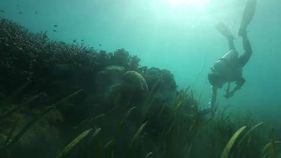Posted on Seattle Times: 18 May 2016 — By Lynda V. Mapes — As levels of carbon dioxide rise in the atmosphere due to fossil fuel burning and other human-caused pollution, it changes water chemistry, hurting survival of crab larvae.
 Greenhouse-gas pollution is expected to reduce the survival of crab larvae. (NOAA)
Greenhouse-gas pollution is expected to reduce the survival of crab larvae. (NOAA)
The Dungeness crab fishery could decline West Coastwide, a new study has found, threatening a fishing industry worth nearly a quarter-billion dollars a year.
Scientists at the Northwest Fisheries Science Center in Seattle found that pH levels likely in West Coast waters by 2100 at current rates of greenhouse-gas pollution would hurt the survivability of crab larvae.
Carbon dioxide, a potent greenhouse gas, is pumped into the atmosphere primarily by the burning of fossil fuels. Levels of atmospheric C02 have been steadily rising since the Industrial Revolution in 1750 and today are higher than at any time in the past 800,000 years — and predicted to go higher.
When carbon dioxide mixes with ocean water it lowers the pH. By simulating the conditions in tanks of seawater at pH levels likely to occur in West Coast waters with rising greenhouse gas pollution, scientists were able to detect both a slower hatch of crab larvae, and poorer survival by the year 2100.
That in turn likely would cause a decline in the population of a fishery that is of economic importance to tribal and nontribal fishers alike. The total value of the 2014 Dungeness crab catch in Alaska, California, Oregon and Washington was $211.5 million, according to data provided by NOAA fisheries.
The crab fishery is of great cultural importance, too, a birthright of tribal and nontribal Northwest residents for whom fresh-caught Dungeness crab defines part of what it means to live here.
Crab larvae also are an important food source for a wide range of sea life, including salmon.
Dungeness crab, Cancer magister, is a denizen of coastal and Puget Sound waters. Adults occur in the inshore waters where pH today in summer can be as high as 7.6, but in the future, are predicted to lower to 7.1.
Using eggs and larvae from females captured in Puget Sound, scientists determined the hatching success, larval survival and larval development rate at three pH levels: 8.0, 7.5 and 7.Three to four times more larvae survived in higher pH than the lower pH tanks. Those larvae also were slower to hatch, said Paul McElhany, a research ecologist at the Northwest Fisheries Science Center and senior author of the paper, published online in the scientific journal Marine Biology last month.
While the eggs studied were taken from crabs collected in Puget Sound, “There’s no reason to suspect coastal crabs would respond differently,” McElhany said.
His lab is continuing to examine effects of acidifying seas on other living things. Next up are salmon, where he wants to learn if acidification affects olfactory capacities, potentially damaging the ability to navigate to their home waters.
Other fish species have been found to be harmed by acidifying waters, including clown fish, which mistake predators for prey as pH plummets.
While effects predicted in the research are forecast for the year 2100, levels of acidification could plunge lower sooner, depending on whether levels of greenhouse-gas pollution are brought under control.
“There is some uncertainty about when we reach these levels,” McElhany said.
Read this article on The Seattle Times online.
